Analysis of the Evolution of the Relationship between the Urban Pattern and Economic Development in Guangdong Province Based on Coupled Multisource Data
Abstract
1. Introduction
2. Study Area and Data
2.1. Study Area
2.2. Data Sources and Processing
3. Methods
3.1. Night-Light Statistics
3.2. Spatial Modeling of GDP
3.3. Dichotomy
3.4. Standard Deviation Ellipse
4. Results and Analysis
4.1. Statistical Results and Night-Light Analysis
4.2. Spatial Modeling of GDP
4.3. Analysis of the Results of Extracting Built-Up Areas by Dichotomy
4.4. Analysis of the Result of the Standard Deviation Ellipse
5. Discussion
5.1. Statistics of the Total Amount of Light at Night
5.2. Spatial Modeling of GDP
5.3. Extracting Built-Up Areas
5.4. Standard Deviation Ellipse
6. Conclusion
Author Contributions
Funding
Data Availability Statement
Acknowledgments
Conflicts of Interest
References
- Guan, X.L.; Wei, H.K.; Lu, S.S.; Dai, Q.; Su, H.J. Assessment on the urbanization strategy in China: Achievements, challenges and reflections. Habitat Int. 2018, 71, 97–109. [Google Scholar] [CrossRef]
- Planning, L. Urban growth pattern modelling: A case study of Wuhan city, PR China Urban growth pattern modeling: A case study of Wuhan city, PR China. Landsc. Urban Plan. 2015, 62, 199–217. [Google Scholar]
- Peng, J.; Lin, H.; Chen, Y.; Blaschke, T.; Luo, L.; Xu, Z.; Hu, Y.; Zhao, M.; Wu, J. Spatiotemporal evolution of urban agglomerations in China during 2000–2012: A nighttime light approach. Landsc. Ecol. 2020, 35, 421–434. [Google Scholar] [CrossRef]
- Fang, C.; Yu, D. Urban agglomeration: An evolving concept of an emerging phenomenon. Landsc. Urban Plan. 2017, 162, 126–136. [Google Scholar] [CrossRef]
- Yu, M.; Guo, S.; Guan, Y.; Cai, D.; Zhang, C.; Fraedrich, K.; Liao, Z.; Zhang, X.; Tian, Z. Spatiotemporal Heterogeneity Analysis of Yangtze River Delta Urban Agglomeration: Evidence from Nighttime Light Data (2001–2019). Remote Sens. 2021, 13, 1235. [Google Scholar] [CrossRef]
- Chu, M.; Lu, J.; Sun, D. Influence of Urban Agglomeration Expansion on Fragmentation of Green Space: A Case Study of Beijing-Tianjin-Hebei Urban Agglomeration. Land 2022, 11, 275. [Google Scholar] [CrossRef]
- Wang, J.; Fang, C.; Wang, Z. Advantages and dynamics of urban agglomeration development on Yangtze River Delta. J. Geogr. Sci. 2012, 22, 521–534. [Google Scholar] [CrossRef]
- Zheng, Z.; Bohong, Z. Study on Spatial Structure of Yangtze River Delta Urban Agglomeration and Its Effects on Urban and Rural Regions. J. Urban Plan. Dev. 2012, 138, 78–89. [Google Scholar] [CrossRef]
- Laurance, J.C.M.; Lin, C. Development of towns in China: A case study of Guangdong province. In Population and Development Review; Population Council: New York, NY, USA, 2017; Volume 19, pp. 583–606. [Google Scholar]
- Huang, Q.; Yang, X.; Gao, B.; Yang, Y.; Zhao, Y. Application of DMSP/OLS nighttime light images: A meta-analysis and a systematic literature review. Remote Sens. 2014, 6, 6844–6866. [Google Scholar] [CrossRef]
- Liu, Z.; He, C.; Zhang, Q.; Huang, Q.; Yang, Y. Extracting the dynamics of urban expansion in China using DMSP-OLS nighttime light data from 1992 to 2008. Landsc. Urban Plan. 2012, 106, 62–72. [Google Scholar] [CrossRef]
- Imhoff, M.L.; Lawrence, W.T.; Elvidge, C.D.; Paul, T.; Levine, E.; Privalsky, M.V.; Brown, V. Using nighttime DMSP/OLS images of city lights to estimate the impact of urban land use on soil resources in the United States. Remote Sens. Environ. 1997, 59, 105–117. [Google Scholar] [CrossRef]
- Small, C.; Pozzi, F.; Elvidge, C.D. Spatial analysis of global urban extent from DMSP-OLS night lights. Remote Sens. Environ. 2005, 96, 277–291. [Google Scholar] [CrossRef]
- Su, Y.; Chen, X.; Wang, C.; Zhang, H.; Liao, J.; Ye, Y.; Wang, C. A new method for extracting built-up urban areas using DMSP-OLS nighttime stable lights: A case study in the Pearl River Delta, southern China. GIScience Remote Sens. 2015, 52, 218–238. [Google Scholar] [CrossRef]
- Ye, Y.; Li, S.; Zhang, H.; Su, Y.; Wu, Q.; Wang, C. Spatial-Temporal Dynamics of the Economic Efficiency of Construction Land in the Pearl River Delta Megalopolis from 1998 to 2012. Sustainability 2017, 10, 63. [Google Scholar] [CrossRef]
- Li, X.; Xu, H.; Chen, X.; Li, C. Potential of NPP-VIIRS Nighttime Light Imagery for Modeling the Regional Economy of China. Remote Sens. 2013, 5, 3057–3081. [Google Scholar] [CrossRef]
- Cao, C.; Xiong, J.; Blonski, S.; Liu, Q.; Uprety, S.; Shao, X.; Bai, Y.; Weng, F. Suomi NPP VIIRS sensor data record verification, validation, and long-term performance monitoring. J. Geophys. Res. Atmos. 2013, 118, 664–678. [Google Scholar] [CrossRef]
- Zheng, Q.; Deng, J.; Jiang, R.; Wang, K.; Xue, X.; Lin, Y.; Huang, Z.; Shen, Z.; Li, J.; Shahtahmassebi, A.R. Monitoring and assessing “ghost cities” in Northeast China from the view of nighttime light remote sensing data. Habitat Int. 2017, 70, 34–42. [Google Scholar] [CrossRef]
- Shi, K.; Huang, C.; Yu, B.; Yin, B.; Huang, Y.; Wu, J. Evaluation of NPP-VIIRS night-time light composite data for extracting built-up urban areas. Remote Sens. Lett. 2014, 5, 358–366. [Google Scholar] [CrossRef]
- Zhao, M.; Cheng, W.; Zhou, C.; Li, M.; Wang, N.; Liu, Q. GDP Spatialization and Economic Differences in South China Based on NPP-VIIRS Nighttime Light Imagery. Remote Sens. 2017, 9, 673. [Google Scholar] [CrossRef]
- Zhang, P.; Liu, S.; Du, J. A Map Spectrum-Based Spatiotemporal Clustering Method for GDP Variation Pattern Analysis Using Nighttime Light Images of the Wuhan Urban Agglomeration. ISPRS Int. J. Geo-Inf. 2017, 6, 160. [Google Scholar] [CrossRef]
- Ma, T.; Yin, Z.; Li, B.; Zhou, C.; Haynie, S. Quantitative Estimation of the Velocity of Urbanization in China Using Nighttime Luminosity Data. Remote Sens. 2016, 8, 94. [Google Scholar] [CrossRef]
- Yu, Z.; Zeng, W.; Cheng, X. The Research on Urban Expansion and Spatial Correlation Based on VIIRS/DNB Data: A Case Study of Shandong Province. IOP Conf. Ser. Earth Environ. Sci. 2021, 714, 022057. [Google Scholar] [CrossRef]
- Henderson, V. The Urbanization Process and Economic Growth: The So-What Question. J. Econ. Growth 2003, 8, 47–71. [Google Scholar] [CrossRef]
- Jiang, Z.; Zhai, W.; Meng, X.; Long, Y. Identifying Shrinking Cities with NPP-VIIRS Nightlight Data in China. J. Urban Plan. Dev. 2020, 146, 04020034. [Google Scholar] [CrossRef]
- Pan, X.-Z.; Zhao, Q.-G. Measurement of urbanization process and the paddy soil loss in Yixing city, China between 1949 and 2000. CATENA 2007, 69, 65–73. [Google Scholar] [CrossRef]
- Yang, Z.; Chen, Y.; Guo, G.; Zheng, Z.; Wu, Z. Using nighttime light data to identify the structure of polycentric cities and evaluate urban centers. Sci. Total Environ. 2021, 780, 146586. [Google Scholar] [CrossRef] [PubMed]
- Yi, K.; Tani, H.; Li, Q.; Zhang, J.; Guo, M.; Bao, Y.; Wang, X.; Li, J. Mapping and Evaluating the Urbanization Process in Northeast China Using DMSP/OLS Nighttime Light Data. Sensors 2014, 14, 3207–3226. [Google Scholar] [CrossRef]
- Zeng, C.; Song, Y.; Cai, D.; Hu, P.; Cui, H.; Yang, J.; Zhang, H. Exploration on the spatial spillover effect of infrastructure network on urbanization: A case study in Wuhan urban agglomeration. Sustain. Cities Soc. 2019, 47, 101476. [Google Scholar] [CrossRef]
- Liu, J.; Zhang, Q.; Hu, Y. Regional differences of China’s urban expansion from late 20th to early 21st century based on remote sensing information. Chin. Geogr. Sci. 2012, 22, 1–14. [Google Scholar] [CrossRef]
- Xin, X.; Liu, B.; Di, K.; Zhu, Z.; Zhao, Z.; Liu, J.; Yue, Z.; Zhang, G. Monitoring urban expansion using time series of night-time light data: Acase study in Wuhan, China. Int. J. Remote Sens. 2017, 38, 6110–6128. [Google Scholar] [CrossRef]
- Kabanda, T. Using land cover, population, and night light data to assess urban expansion in Kimberley, South Africa. S. Afr. Geogr. J. 2022, 1–14. [Google Scholar] [CrossRef]
- Jiang, Y.; Sun, S.; Zheng, S. Exploring Urban Expansion and Socioeconomic Vitality Using NPP-VIIRS Data in Xia-Zhang-Quan, China. Sustainability 2019, 11, 1739. [Google Scholar] [CrossRef]
- Pan, J. Area Delineation and Spatial-Temporal Dynamics of Urban Heat Island in Lanzhou City, China Using Remote Sensing Imagery. J. Indian Soc. Remote Sens. 2016, 44, 111–127. [Google Scholar] [CrossRef]
- Liang, H.; Guo, Z.; Wu, J.; Chen, Z. GDP spatialization in Ningbo City based on NPP/VIIRS night-time light and auxiliary data using random forest regression. Adv. Space Res. 2020, 65, 481–493. [Google Scholar] [CrossRef]
- Shi, K.; Yu, B.; Huang, Y.; Hu, Y.; Yin, B.; Chen, Z.; Chen, L.; Wu, J. Evaluating the ability of npp-viirs nighttime light data to estimate the gross domestic product and the electric power consumption of China at multiple scales: A comparison with DMSP-OLS Data. Remote Sens. 2014, 6, 1705–1724. [Google Scholar] [CrossRef]
- Ma, J.; Guo, J.; Ahmad, S.; Li, Z.; Hong, J. Constructing a New Inter-Calibration Method for DMSP-OLS and NPP-VIIRS Nighttime Light. Remote Sens. 2020, 12, 937. [Google Scholar] [CrossRef]
- Hesong, D.; Renjie, L.I.; Jianming, L.I.; Shuai, L.I. Study on urban spatiotemporal expansion pattern of three first-class urban agglomerations in China derived from integrated DMSP-OLS and NPP-VIIRS nighttime light data. J. Geo-Inf. Sci. 2020, 22, 5001161. [Google Scholar]
- Zhao, M.-M.; Li, R. Decoupling and decomposition analysis of carbon emissions from economic output in Chinese Guang-dong Province: A sector perspective. Energy Environ. 2018, 29, 543–555. [Google Scholar] [CrossRef]
- Shi, L.; Wurm, M.; Huang, X.; Zhong, T.; Leichtle, T.; Taubenböck, H. Urbanization that hides in the dark—Spotting China’s “ghost neighborhoods” from space. Landsc. Urban Plan. 2020, 200, 103822. [Google Scholar] [CrossRef]
- Lefever, D.W. Measuring Geographic Concentration by Means of the Standard Deviational Ellipse. Am. J. Sociol. 1926, 32, 88–94. [Google Scholar] [CrossRef]
- Wang, F. The Spatial Evolution Analysis of Manufacturing Industrial Gravity Centre of Guangdong Province. Am. J. Ind. Bus. Manag. 2018, 08, 721–734. [Google Scholar] [CrossRef][Green Version]
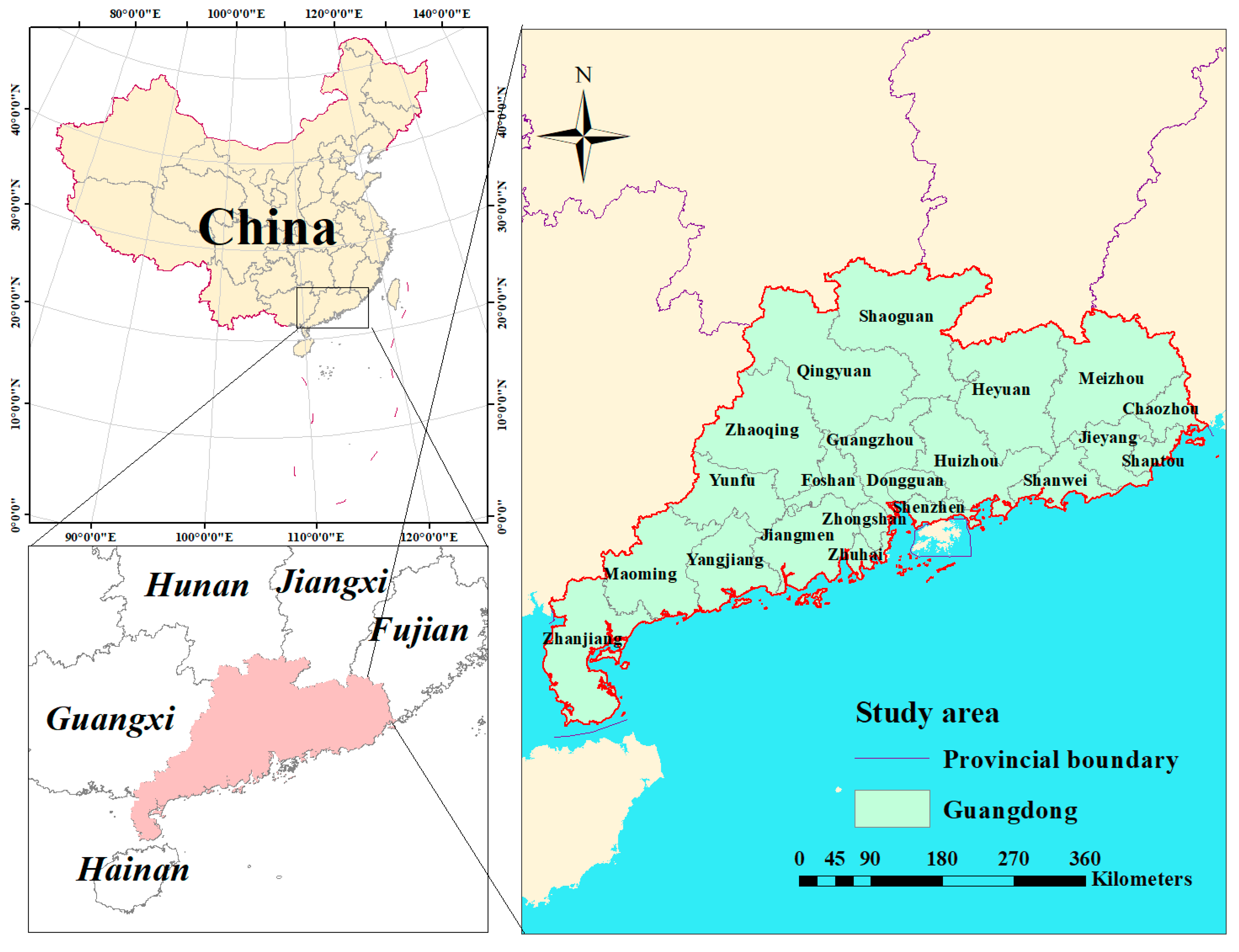
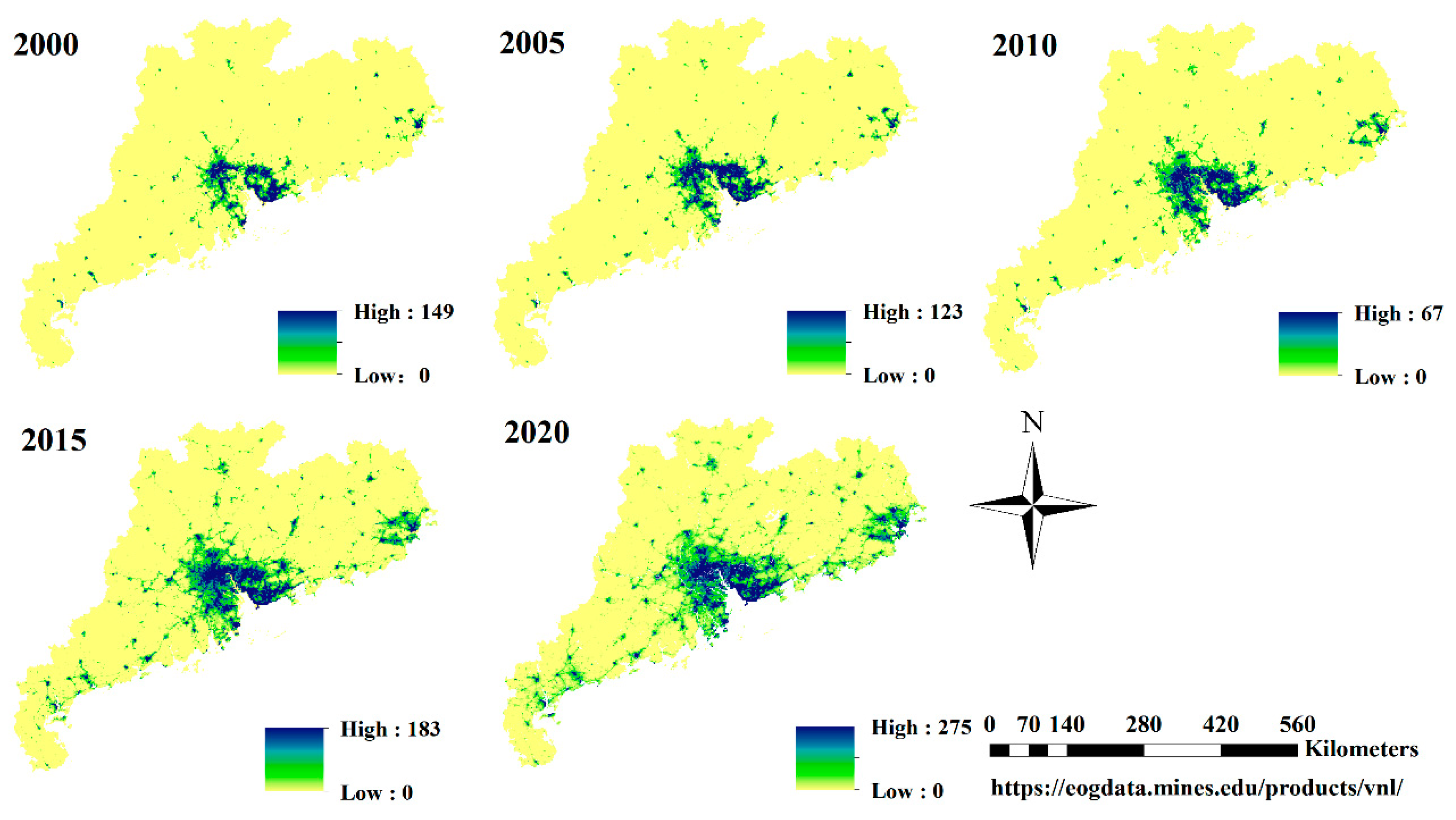

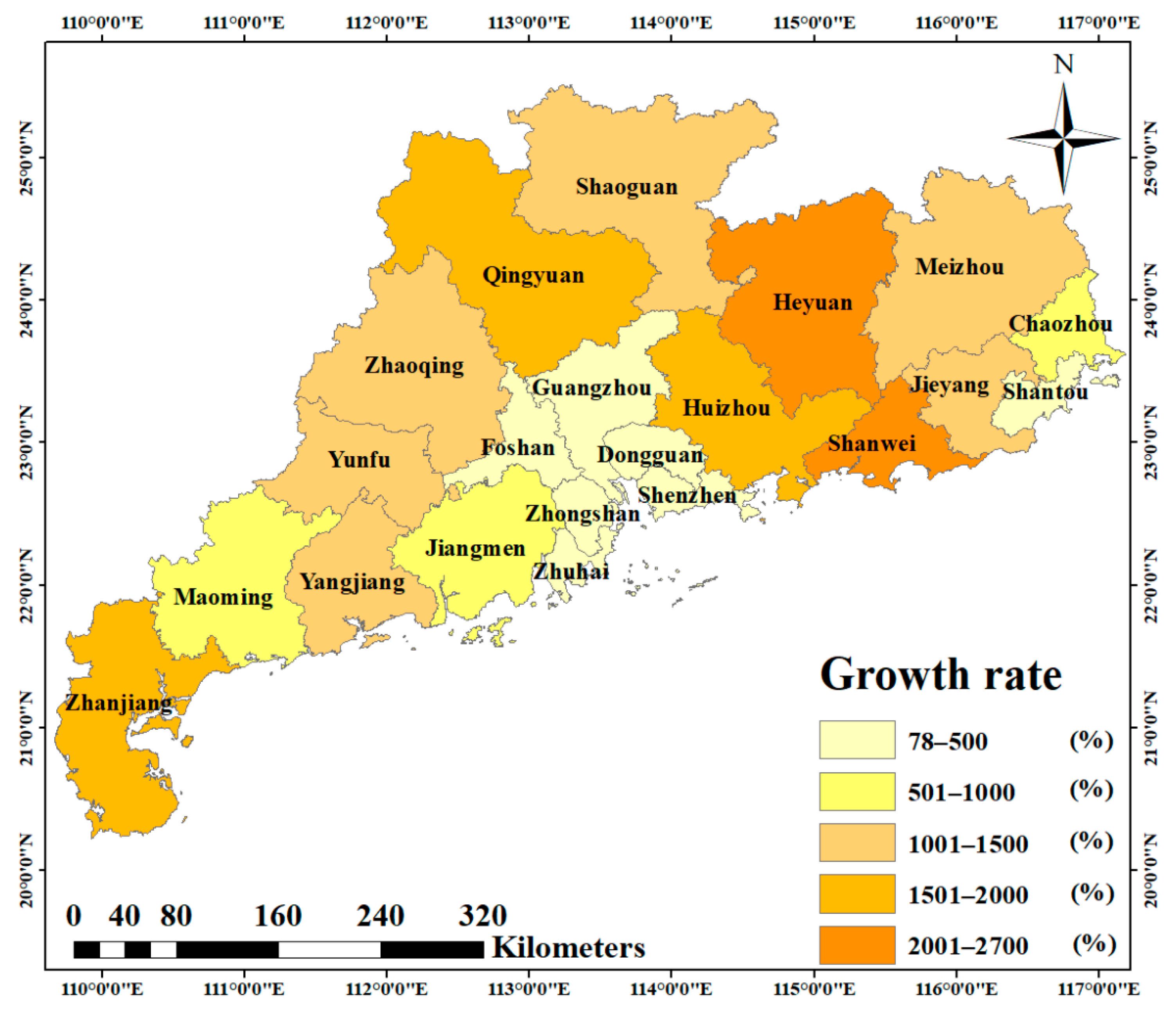
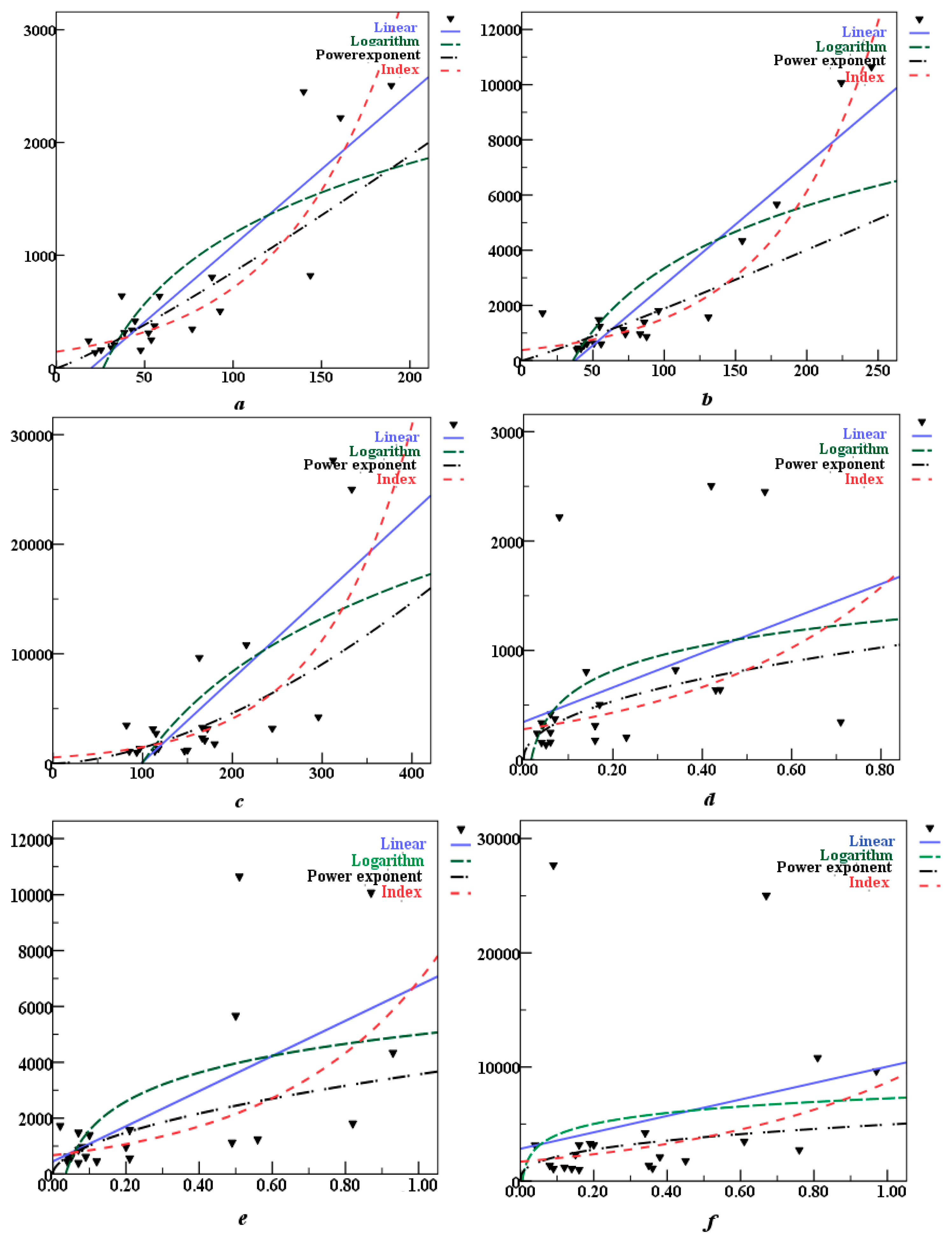

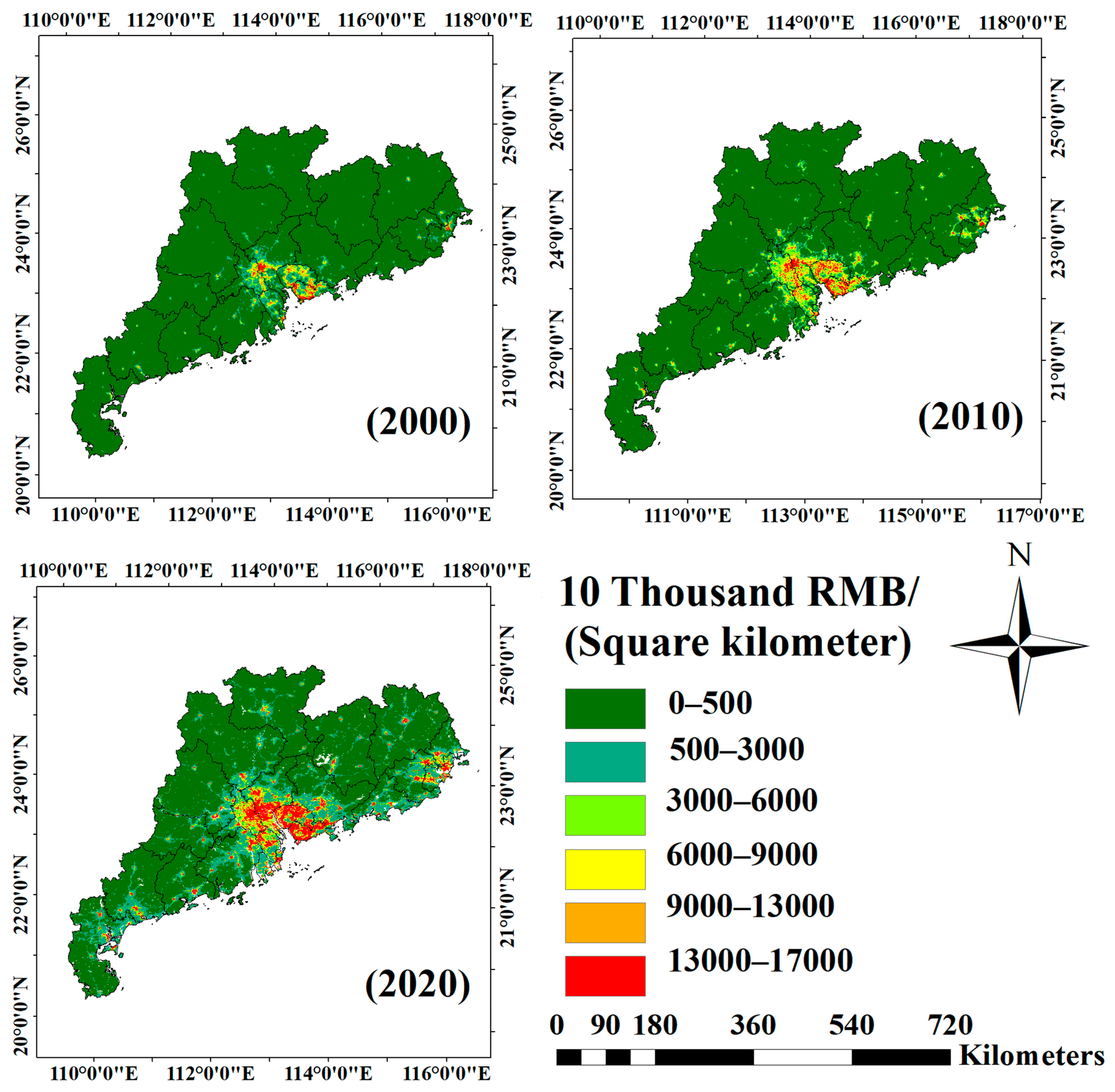


| TNL | I | |||||
|---|---|---|---|---|---|---|
| Year | 2000 | 2010 | 2020 | 2000 | 2010 | 2020 |
| Linear | 0.782 | 0.775 | 0.745 | 0.336 | 0.410 | 0.179 |
| Logarithm | 0.650 | 0.615 | 0.598 | 0.404 | 0.429 | 0.193 |
| Power exponent | 0.874 | 0.836 | 0.841 | 0.482 | 0.549 | 0.344 |
| Index | 0.740 | 0.814 | 0.830 | 0.396 | 0.471 | 0.337 |
| Index | 2000 | 2005 | 2010 | 2015 | 2020 |
|---|---|---|---|---|---|
| Total area/km2 | 1634.78 | 3169.05 | 4618.07 | 5654.78 | 6501.44 |
| Growth area/km2 | — | 1984.27 | 999.02 | 1036.71 | 846.66 |
| Rate of expansion (km2/a year) | — | 396.854 | 199.804 | 207.342 | 169.332 |
| Expansion strength (%) | — | 24.27 | 5.52 | 4.49 | 2.99 |
| Year | Range /km2 | Offset Distance/km | Difference Value/km | Main Direction of Movement |
|---|---|---|---|---|
| 2000 | 23,919.95 | — | 166.089 | — |
| 2005 | 24,793.44 | 5.68 | 169.983 | Northwest |
| 2010 | 25,007.75 | 5.7 | 175.756 | Southwest |
| 2015 | 29,238.9 | 17 | 193.962 | Northwest |
| 2020 | 29,919.49 | 4.93 | 204.842 | Northwest |
Publisher’s Note: MDPI stays neutral with regard to jurisdictional claims in published maps and institutional affiliations. |
© 2022 by the authors. Licensee MDPI, Basel, Switzerland. This article is an open access article distributed under the terms and conditions of the Creative Commons Attribution (CC BY) license (https://creativecommons.org/licenses/by/4.0/).
Share and Cite
Li, P.; Hao, S.; Cui, Y.; Xu, Y.; Liao, C.; Sheng, L. Analysis of the Evolution of the Relationship between the Urban Pattern and Economic Development in Guangdong Province Based on Coupled Multisource Data. ISPRS Int. J. Geo-Inf. 2022, 11, 512. https://doi.org/10.3390/ijgi11100512
Li P, Hao S, Cui Y, Xu Y, Liao C, Sheng L. Analysis of the Evolution of the Relationship between the Urban Pattern and Economic Development in Guangdong Province Based on Coupled Multisource Data. ISPRS International Journal of Geo-Information. 2022; 11(10):512. https://doi.org/10.3390/ijgi11100512
Chicago/Turabian StyleLi, Pengfei, Shuang Hao, Yuhuan Cui, Yazhou Xu, Congcong Liao, and Liangliang Sheng. 2022. "Analysis of the Evolution of the Relationship between the Urban Pattern and Economic Development in Guangdong Province Based on Coupled Multisource Data" ISPRS International Journal of Geo-Information 11, no. 10: 512. https://doi.org/10.3390/ijgi11100512
APA StyleLi, P., Hao, S., Cui, Y., Xu, Y., Liao, C., & Sheng, L. (2022). Analysis of the Evolution of the Relationship between the Urban Pattern and Economic Development in Guangdong Province Based on Coupled Multisource Data. ISPRS International Journal of Geo-Information, 11(10), 512. https://doi.org/10.3390/ijgi11100512






